See here for the latest information
Progress of decommissioning at the nuclear power stations
Fukushima Prefecture's efforts towards decommissioning
"~Fukushima Today~Steps for Reconstruction and Revitalization in Fukushima Prefecture"
"Contaminated water" refers to radiation-tainted water.
Under the ground of the Fukushima Daiichi Nuclear Power Station, there is groundwater flowing toward the sea. Every day, approx. 100 to 200 tons of this groundwater flows into reactor buildings Nos. 1 to 4, which were affected by the nuclear disaster. In the underground area of those reactor buildings, groundwater is flowing into this highly-concentrated, contaminated water, thus increasing the overall volume of contaminated stuff.
Under the "Three Principles," various measures are being taken to prevent the contaminated water from flowing into the sea.
The Three Principles guiding the measures taken against contaminated water
- Remove the contamination source.
- Prevent groundwater from approaching the contamination source.
- Do not allow leakage.
Measures against contaminated water
Groundwater seeps into the nuclear reactor buildings, causing an increase of 150m3/day of contaminated water. The following measures are being taken at the F1NPS for the processing and control of the contaminated water.
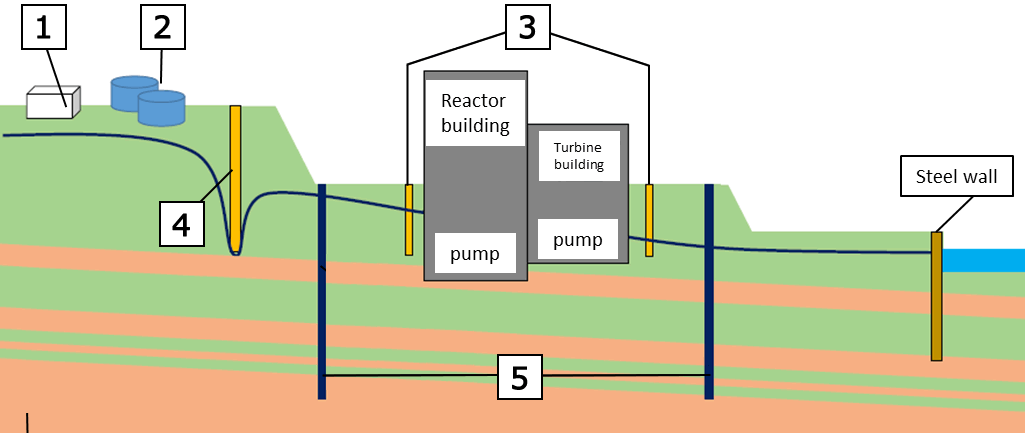
1.ALPS
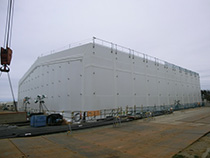 |
Removing radioactive substances (except tritium) from contaminated water. |
2.Contaminated Water Tanks
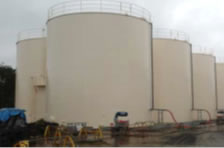
3.Sub-drain
Pumping of groundwater from the wells around the buildings allows control of the amount of water seeping into the buildings. Water pumped will go through the purification process, and be discharged to the sea only if the radiation levels are confirmed to meet discharge standards.
4.Underground water bypass
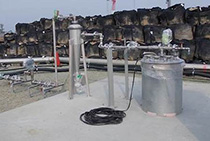 |
By pumping up groundwater before it is contaminated using wells located on the mountain side of the site and discharging it into the sea, the amount of groundwater seeping into the buildings can be controlled . |
5.Cryogenic ice wall
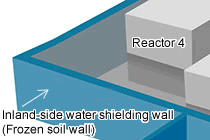 |
By embedding freezing pipes around the building, groundwater and soil can be frozen to make ice walls. This system prevents water from approaching the reactor building and suppresses the flow of groundwater. |
Main measures
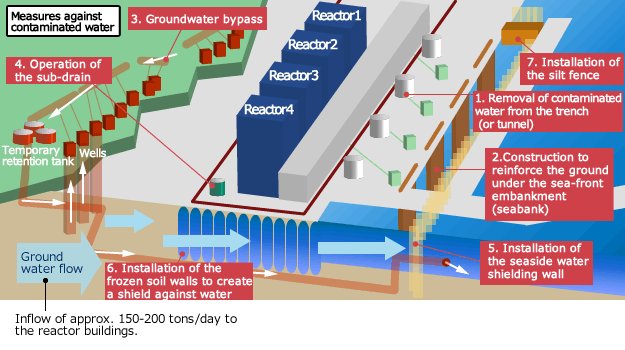
- Emergency measures
1. Removal of contaminated water from the trench (or tunnel)
To remove
The tunnels through which power supply cables and pipes are laid have been filled with concrete in order to prevent a build-up of highly-concentrated, contaminated water which may leak again.
2. Construction to reinforce the ground under the sea-front embankment (seabank)
Do not allow leakage
"Soil walls" are built by injecting the chemical solution (liquid glass) into the seabank ground to prevent contaminated water from flowing into the sea.
3. Groundwater bypass
Stop the approach of groundwater
The well was built to drain away groundwater not yet been contaminated. In April 2014, consent to discharge this drained water into the sea was given by representatives of the fisheries industry and others. On May 21, 2014, this discharge began.
- Drastic measures
4. Operation of the sub-drain
Stop the approach of groundwater
The wells that were dug newly and had been present near the reactor buildings Nos. 1 to 4 before the disaster.
In August 2015, consent to discharge this drained water into the sea was given by representatives of the fisheries industry and others. On September 14, 2015, this discharge began.
5. Installation of the seaside water shielding wall
Prevent leakage
An approx. 780 m long wall is to be constructed by driving a series of piles of 1.1 to 1.2 m in diameter and 30 m in length in the port area. With the joints filled with rubber, etc., the wall will be set some 2 m from the seabank.
Then this gap between the seabank and the wall is filled in to prevent contaminated water from leaking into the sea.
6. Installation of the frozen soil walls to create a shield against water
Stop the approach of groundwater
The walls are constructed by freezing the soil around the reactor buildings Nos. 1 to 4 in order to prevent the groundwater from flowing into those buildings.
- Others
7. Installation of the silt fence
Prevent leakage
The underwater curtain installed to prevent radioactive substances from spreading from around the water intake port into the open sea.
8. Stable operation and expansion of the Multi-nuclide Removal Facility (Advanced Liquid Processing System, ALPS)
Removal
All 62 radionuclides, except tritium, are removed from the contaminated water.
Though the treatment process had been halted repeatedly because of troubles, it has been stably operated since the end of 2014.
9. Measures against leakage from contaminated water storage tanks and these measures may be expanded
Do not allow leakage
The conventional, bolted-type of tanks storing contaminated water are being replaced with welded-type tanks ? and the number of tanks is also being increased.



